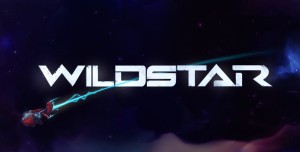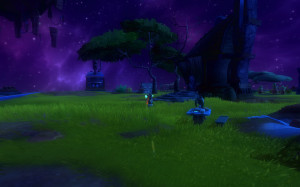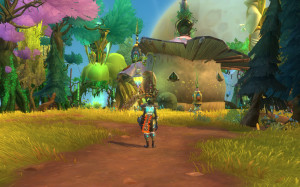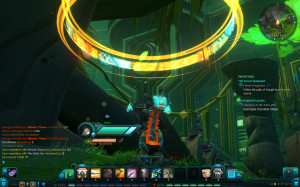Massively Multiplayer Online Role Playing games seem to have been in a rut as of late. If there has not been a plethora of pointless World of Warcraft clones, there are those that try to evolve the formula to limited success, because they are ultimately trying to emulate Warcraft’s success. Challengers who tried to kill it came in the form of Age of Conan Online, Warhammer Online, and Dungeons and Dragons Online, and failed miserably. Most notably was Star Wars: The Old Republic, however, the writers could only do so much since Kreia, the only interesting character that was from the Obsidian developed Knights of the Old Republic 2, was mysteriously forgotten in the lexicon of Star Wars card board cut outs.
Wildstar’s story began in 2007, when Carbine Studios, a Frankenstein amalgamation of developers from Blizzard, Retro Studios, Bethesda, and Valve and attached to noted publisher NCSoft, began to work on a project that wanted to give more flexibility to the individual player in 2011. Which was a noble ideal, considering most MMOs allow a player to start as a class, give a starting quest to procure ten bear butts, and then leave off with no concrete path on where to go.
Through the development process, Carbine was able to come to the conclusion that MMO goers were comprised of four particular types of players: Explorers, Lore Junkies, PvPers, and the Socials. Using this, Carbine was able to create Paths; questlines tailored to the specific things that those players enjoyed. The Explorers could jump their way to places to get the best view and, subsequently, go to places that the developers would rather them not go, especially with the double jump feature. Those who loved stories could watch it unfold as Scientists, who are also given a hovering, mechanical companion to give additional context to the world around them. PvPers, also known as Soldiers, could stick to doing what they loved, fighting others and mercilessly killing lower level players with impunity. Finally, the Settlers, for those who prefer a more social experience, go through the game building structures that can provide assistance to other types of players throughout the zone.
As interesting as the prospect of differing playstyles is, it does not mean much unless the world around the player would offer a compelling story to go with it. Wildstar is science fiction to its core. However, great care was taken to ensure that the story has the kind of pull needed to guide the players. It leads to a slight detriment here, as the playerbase is divided between two factions: the Dominion and the Exiles. However, there have been checks and balances made during the story so that one side is not seen as more domineering over the other when it comes to story content.
The Dominion is best described as a mixture of the Imperium from Warhammer 40k and the Horde of World of Warcraft. They are allegedly noble, violent, and with a misplaced sense of manifest destiny. The difference being that the Dominion are aware that they have committed acts of wholesale murder, racism, and attempted genocide. They do not care how their actions are perceived. They revel in it as they attempt to maintain their stranglehold on the galaxy, despite being stopped cold by the golem-like Granok. The races of the Dominion fit the theme well and include the humans of the aristocracy from the planet Cassus, the obvious vanilla choice; the unfeeling Mechari, creations of the god-like Elden; the Chua, monogendered rodents with a penchant for creating things that destroy things; and the Draken, bestial warriors who just want to kill for the sake of killing.
In contrast are the Exiles, so called because all the races have been exiled from their homeworlds for one reason or another. The Exiles include the humans, these from the group known as outcasts, who wage class warfare against of the Dominion’s aristocracy; the aforementioned Granok, who make up the muscle of the Exiles and work as mercenaries; the animal-like Aurin, who saw their planet obliterated for aiding the Exiles in the first place, and the race the anime fans will adore, due to their animal ears, inexplicably prehensile tails, and love of nature; Finally, the Mordesh, a race of tall, mad scientist-like, cyborg zombies on the brink of extinction who, strangely enough, get along better with the Aurin than anyone else.
The story of the game itself begins when an Exile explorer finds an unknown planet named Nexus, which some believe to be the homeworld of the now vanished Elden. The Exiles go there in hopes of starting over and building anew, yet The Dominion also arrive to uncover Elden secrets.
The art style and the world ooze personality. The landscapes are varied and colorful, even more so than most games. And the questing is always within context of the path the players take, which somehow makes collection quests not as boring as it would be in other games. For example, every zone has a series of quests that have a time limit on it, whether it is a mob elimination or gathering items. These quests offer bronze, silver, and gold level rewards if the player can achieve the required number of kills/collections. The rewards can vary between crafting materials, gold, and equipment. This also leads to the fact that the player can salvage unneeded equipment into materials to assist in building more equipment or have it go into the player’s house.
Yes, player housing plays a large role in this game. Carbine made sure that the player has all the tools they need in order to create a place that is not only tailored to their likes, but can also serve practical functions from giving Rested XP bonuses, to creating farms for specific materials, and even entrances into dungeons that can only be accessed by the entrance at the player’s plot of land. In addition, friends of the player can visit when the player is not around and farm the materials and will be sent to the home owner, with the visitor gaining a bit of the materials for their troubles.
Next, comes the combat system. Unlike the combat system of most other MMOs, where the player has to acquire a target to find out the enemy’s health and status, Wildstar emplys a more interactive system they call Free-Form Targeting. It brings to mind Area of Effect attacks from World of Warcraft, as it shows a line of fire where the attack will hit, but unlike the aforementioned, this affects all attacks and are not limited to just a few special abilities. The end result is a skill-based combat system that gives more responsibility to the player. Or it will just show how awful those DPS players are when they refuse to move, completely ignoring the fact that a large red circle on the ground is growing larger by the second. In addition, dashing and dodging are also employed, so as to give PvPers more chances to dodge attacks, escape, or adjust their position to maximize the advantage.
While Wildstar does so many things right, it is not perfect. The controls can seem slightly sluggish at times, especially in PvP battlegrounds where many combat effects are on display. Being released only a few months ago, it can be a demanding game on older systems. This is offset, however, by the fact that the amount of choice the player is given allows them to play at their own pace and still progress.
Another major ding against it is its instance to use a subscription model, when most others have eschewed that for Free-to-Play monetization. However, those with business savvy can learn how to buy and sell items on the in game auction house and use the money to purchase a special currency called C.R.E.D.D. and use that to purchase game time, much like ISK in Eve Online. An in-game entrepreneur would be able to not pay a thing toward the subscription cost or sell it to other players if they were so inclined. Also, players of the game are given keys to give to those interested in giving the game a try.
Overall, Wildstar is a game that does many, many things right. And save for the few flaws in the control and subscription, it is well worth a look for anyone wanting a change of pace from the standard MMO fare.




